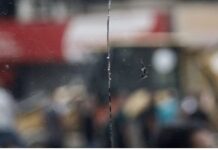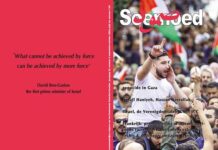AJ Staff
Al-Jazeera / August 25, 2024
Al-Tabin School was not the first school in Gaza that Israel has targeted. But medics, journalists and survivors told Al-Jazeera that Israel’s August 10 attack on it was the most gruesome massacre since Israel launched its assault on the besieged enclave in October last year.
Israel killed more than 100 displaced Palestinians, leaving victims dismembered, charred and often unidentifiable by their loved ones.
Some 2,400 displaced Palestinians, many exhausted by having been displaced several times, were sheltering in the school in eastern Gaza’s Daraj neighbourhood when it was struck by two guided missiles.
The missiles blazed through the upper level, a space that women and children slept and prayed in, to reach the men’s prayer area on the ground floor.
Most of the men and boys had woken up to perform the Fajr – or dawn – prayers and were gathered in that space. It was timed for maximum casualties, medics who were there said.
The nearby Al-Ahli Arab Hospital – which came under attack months ago and is only partially operational with no burn ward – was overwhelmed as injuries and bodies of slain Palestinians began pouring in.
Throughout the war, Israeli forces have largely kept Gaza’s vital crossings sealed shut, blocking the entry of much-needed fuel, medicine and humanitarian aid to the enclave, where famine is looming.
Al Jazeera spoke to some of the displaced people who survived the attack but lost loved ones, as well as rescue workers and medics who worked in mute horror to save as many people as they could.
Sumaya Abu Ajwa had woken up for the Fajr prayer with her two foster daughters, 16-year-old Nuseiba and 14-year-old Retaj, and their mother.
She and the girls’ mother were off to one side when the missiles struck, one of them passing between the two girls, Abu Ajwa told Al-Jazeera.
“Suddenly, dust and fire spread everywhere, like it was Judgement Day. I started looking frantically for the girls,” she says tearfully, sitting on a bed because she has difficulty walking.
“I found the younger girl [Retaj] and held her in my arms. Her blood was pouring onto my clothes, but I could sense that she was still breathing,” Abu Ajwa said, adding that she screamed for help, for anyone to come and save Retaj, but the scene was so chaotic nobody was able to help.
Soon after, Retaj succumbed to her wounds.
The search for Retaj’s big sister Nuseiba took longer.
“I went back into the flaming prayer room over and over, looking for her, I couldn’t see her anywhere. Then someone told me that she was under the rubble so I went to look where they said.
“When I reached her,” Abu Ajwa breaks down, “I found her and her body had been torn in two.”
Weeping bitterly, she said she and the girls’ mother had done everything they could, through several displacements, to keep the four of them together.
Abu Ajwa had discussed leaving Al-Tabin with the girls, but Nuseiba had been reluctant to leave, she said, because she was attending Quran classes there and was proud of her progress in memorizing the holy book.
“She told us that if we wanted to leave that was fine, she would stay behind in the school. I told her that I had stayed with them throughout the war and wouldn’t leave them now, we’d either make it together or die together, but now they’ve gone on ahead and left us. They died before us.”
The girls only had one wish, she added – for the war to end because they “have been scared so many times, displaced so many times, they were so exhausted and had gone hungry so many times”.
The girls have a 14-year-old brother, Abu Ajwa said, who had been taken from them when the Israeli army raided Al-Shifa Hospital where they were sheltering at the time.
“The Israelis sent him north on his own. We were very sad then but, who knows, this may have saved him, he’s the only hope we have left.
“Who will call me Mama Sumaya now? I crave those words so much,” Abu Ajwa sobs.
Suzan al-Basyouni heard the impact first then realized that the school had been targeted, with the mosque hit hardest, and ran to look for her husband who had gone to perform the Fajr prayer.
“The moments of the massacre are etched into my eyes… imagine looking for your husband amid piles of human body parts, to try to identify him and not be able to,” Al-Basyouni told Al-Jazeera.
“Inside the mosque were piles of bodies, dismembered limbs flung around. Those very few who survived were running out of the mosque screaming, in flames.
“I was struggling to get through, stepping on bodies with my own two feet. I stepped on a woman as I was trying to find my husband. I know her, she’s a friend of mine and I didn’t realize that I was stepping on her. She was at the mosque’s entrance.”
The dark made it hard for Al-Basyouni and her family to find her husband and it was only when the sun rose and rescue efforts advanced a bit that they found him under a pile of bodies.
“His legs had been blown off and his abdomen torn open. He had been martyred alongside his father.
“My solace, my only hope now is that we will find ease in heaven. There is no life left to live in Gaza, we had no idea how horrific life could be and now we know that it’s all over.
“There will be no earthly justice, how could there be when we live in Gaza and nobody has moved to help us? Justice will be served by God alone.”
Vascular surgery consultant Tayseer al-Tanna stood in shock in the hospital corridor, recounting what he saw after the attack in a voice he was trying to control.
“I deal in science,” he said. “So, I try to use my head more than my heart when it comes to treating people.
“But that day, what I saw and what I had to do, I was working with a vice gripping my heart. Yet I kept working, I couldn’t stop.”
The severity and sheer number of injuries he encountered have left a lasting impression on Al-Tanna.
“The burns were unlike anything I’ve seen before, covering 50…70… up to 90 percent of the victims’ bodies. Many lost limbs, and so many died in surgery because their injuries were so severe,” he said.
Al-Tanna used to work at Al-Shifa Hospital and is now the only vascular surgeon remaining in northern Gaza, working out of Al-Ahli Arab Hospital where he receives cases from all over the north.
Al-Jazeera Arabic’s Anas al-Sharif was among the first journalists who reported on the direct aftermath of the attack.
“I wasn’t prepared for what I saw. The number of martyrs was beyond anything I could have imagined,” al-Sharif said.
“There were bodies and limbs outside the school, but nothing could prepare me for the scenes inside. I documented what was happening outside the school and kept going.
“But when I got to the mosque that had been targeted, I was so shocked that I had no words left any more,” he recalled.
“I was walking over the bodies of martyrs without realising it. A very painful scene unfolded in front of me, a girl saying goodbye to her father as he died from his burns,” he said.
“It’s difficult to move past something like this. Those images, I see them everywhere… in my dreams, when I’m awake.”
Asked whether this shock could make him give up journalism, al-Sharif said seeing such a crime being perpetrated against the people of Gaza only makes him more determined to carry on documenting what is happening.
“There are still families who haven’t found their loved ones,” he said. “The victims are nothing more than body parts.
“I went to the school after the attack and saw some families trying to clean it up, they were collecting kilos and kilos of just body parts, they don’t know who they are.”
‘Engulfed in flames … their limbs blown off’
Momen Silmi, a civil defence worker who was among the first to reach the school, said the scenes at al-Tabin were “terrifying”, with people standing outside the school, afraid to enter.
When he and his team entered, they found the scene of the strike in flames, upstairs and down.
“Some of the victims were engulfed in flames, but they couldn’t extinguish the fire because their limbs had been blown off.
“No human should have to witness such a sight,” Silmi said. “But we’ve seen so much, we were able to go in there and try to help. I would grab anything I could find and try to put out the fires that were burning some of the injured people.
“We went upstairs and the sight I saw there was appalling. Most people were burned, dismembered, disembowelled, and they were all women and children. There were no men, not even teenagers up there.
“I saw an injured mother holding her daughter of about 18 or 19 who was badly injured… her intestines were spilling out and her hands had been blown off. She had her eyes closed and was screaming out for help: ‘Baba! Don’t leave me please!’ she was crying, holding on to me because she thought I was her father.
“I was trying to help her while my colleague was trying to calm her mother down because she was bleeding profusely as well.
“We were all deeply branded by this experience, yes we’ve seen a lot and helped a lot of people in terrible conditions, but working on a disembowelled injured person while their seriously injured parent or child looked on wailing, that was horrific and will stay with us forever.”
‘Not just a massacre’
“I had just woken up really, we were about to pray Fajr at the civil defence centre,” rescue worker Noah al-Sharnoubi said.
“As I walked through the carnage, I felt like I was in a dream. There were tens of bodies piled up, and dismembered body parts were strewn everywhere.
“We’ve seen schools targeted before, we knew to expect a dozen casualties maybe, but this time the number of bodies and injured screaming for help…
“People were screaming out to me to save their mothers, brothers, and fathers, grabbing me in desperation. Sometimes I would go to them and find that their loved ones were taking their last breaths, and I would have to leave to help someone else.”
Al-Sharnoubi kept working alongside his team until all the injured people on the ground floor had been taken to hospital, then he headed upstairs to help out there too.
“As I was going up the stairs, I saw a human head on the steps with a fire blazing nearby. It was a head with part of the shoulders still attached.
“I tried to move it with my hands, but they started trembling … I lost control of myself and couldn’t lift bodies or help the injured,” he said.
All the rescue workers on the site cried at some point, he added, because of the severity of the attack.
“I haven’t slept for three days since the massacre. The images keep replaying in my mind. This wasn’t just a massacre – it was a genocide against displaced people who sought refuge in a school.
“Believers were killed while they prayed; they were children, women and the elderly.”
Source: Al-Jazeera












